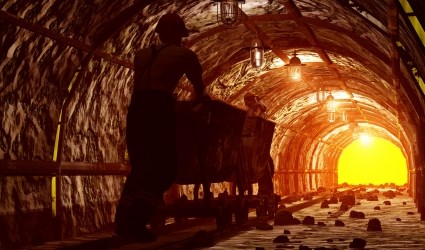Putting out fires with Inertisation Units
If a fire breaks out in a mine it can cause death, disrupt and damage the local community, and depending on the circumstances, can burn for decades or even hundreds of years. Inertisation Units are important as they ensure fires are eliminated quickly, so it’s vital that they are working correctly. While not commonly utiliised, SCADA systems can allow for greater control of the unit and improve safety at the site.

Controlling and suppressing fires
The Górniczy Agregat Gaśniczy, better known as GAG, is a jet engine inertisation unit developed to control and suppress coal seam fires, and neutralise firedamp situations.
It works by drawing air in through a cloth filter, where it is injected with kerosene and ignited by spark plugs to reduce the oxygen content to approximately 17 per cent.
The energy of the fumes’ flow powers the compressor part of the turbine, fuel pumps and electricity generating systems. Additional fuel is then injected under high pressure into the afterburner where the fuel evaporates and burns instantly, further reducing the oxygen level to approximately 2-4 per cent.
The exhaust gases are then cooled with water, resulting is a wet inert mixture of fumes, water vapour and water droplets.
This ‘gas’ is then transferred via an air duct to the hazardous section of a mine and forced onto the flames at intense pressure, smothering the fire and depriving it of any oxygen to extinguish the blaze.
Experience to meet the challenges
Geoff Bladon, Business Development Director at Automation IT, said automating such systems can be a challenge for inexperienced automation engineers, as the unit needs to perform in intense conditions whilst remaining extremely accurate, reliable and safe.
“When a fire at a mine occurs, the Inertisation Unit is called out to extinguish it as soon as possible, so it is imperative that the unit functions correctly or the safety of the whole team could be jeopardised,” Mr Bladon said.
“It is for this reason that every precaution needs to be thought of when designing an automation solution for an Inertisation Unit, so that the operator remains in full control of the GAG turbine at all times and suitable safety measures be set in place in the event of an emergency.
“Automation projects such as this are unusual, and require highly experienced automation engineers to complete. Automation IT has taken on numerous unusual and difficult projects such as this and successfully provided an automated solution that meets project needs and complies with all standards.”
Providing a customised solution
One such project undertaken by Automation IT was to design an automated simulation program to train personnel without having to run the jet engine. Running the Jet Inertisation unit is very expensive and to have the ability to train operators without actually having to start the engine is a great benefit to the mine rescue team.
“We successfully automated this system, and was able to increase the accuracy and reliability of the Jet Inertisation Control Unit, as well as ensure the safety of the personnel operating the machine,” Mr Bladon said.
“Furthermore, with the new control system we developed the operating and maintenance costs of the unit were dramatically reduced due to the increased control and analysis tools. Each step of the inertisation process can be monitored more closely, reducing waste and increasing efficiency.”
As with all projects Automation IT undertake, the client was provided with detailed operations and maintenance manuals to keep for reference should questions arise about the PLC or software, or it needs to be upgraded in the future. They were also provided with monthly progress reports throughout the project, detailed software programming specification, an electrical drawing package, and full test documentation.

